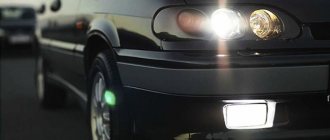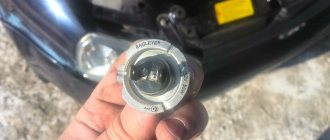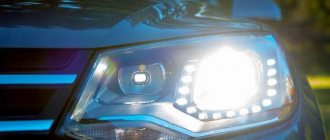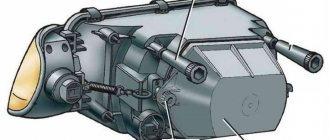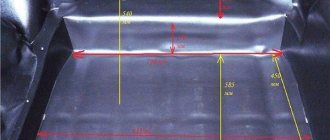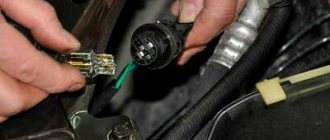DRLs (daytime running lights) are additional lighting devices installed on a car for use during daylight hours. I would like to emphasize that DRLs are intended to indicate your vehicle in front of other road users, and not to provide additional illumination of the roadway. There is no doubt about the benefits of using DRLs; your car will become noticeable at a distance of several kilometers. This is achieved by using bright LEDs in the DRLs. In this article, I will tell you about the legal aspects of installing DRLs, as well as the various DRL wiring diagrams.
↑ Here is the diagram:
Fragment excluded. The full version is available to patrons and full members of the community.
As we can see there are a few details, there is no rare beast, I only bought a relay for 40 rubles, a 5-pin one from a VAZ.
Appearance of the relay itself
Here is a photo of the newly assembled device (I’m again in my spirit, I’m assembling with a hinged installation; externally, the relay will be no different from its brothers).
High beam as DRL
There is an idea to make a low beam as a DRL (like the Americans have).. When you turn on the ignition, the low beam lights up to the floor, and when you turn on the headlights, it goes out. Pros: the dimensions do not light up, you do not need to turn on the fog lights/headlights at full intensity, the interior lighting does not dim, you only need 3 relays for implementation.
In this case, you need to cut it off initially - on the first lamp.
What could be the pitfalls? Maybe someone did something similar?
Visitor Registration 09/07/2012 Messages 47 Said thanks 2 Thanked 4 times in messages
Super Moderator
Registration 07/06/2006 Messages 8,113 Said thanks 2,504 Thanked 6,059 times in messages
Old resident Registration 10/25/2010 Messages 2,444 Said thanks 91 Thanked 450 times in messages
Posted by alexd
Super Moderator
Registration 07/06/2006 Messages 8,113 Said thanks 2,504 Thanked 6,059 times in messages
Old resident Registration 12/06/2010 Messages 3,012 Said thanks 484 Thanked 884 times in messages
Alexey, look at the diagram for switching on the radiator fans on 2AZ-FE: 07EWD.pdf. Same principle. Instead of motors, substitute your own lamps
Expert Registration 05/01/2009 Messages 1,306 Said thanks 49 Thanked 220 times in messages
crystallization of the neighbor's thread and so it is. Do you still want to finish it off? do high beam
at full intensity. there the lamp is rarely used for its intended purpose and therefore its destruction is not so critical.
Guest Registration 01/29/2011 Messages 201 Said thanks 14 Thanked 32 times in messages
I've had the same one for 3 years now, I don't remember what it's called. I’ll go to the car later, there’s a piece of paper about the installation left somewhere. How DRL justifies itself. And yes, not the near one but the far one is at full heat, there is xenon on the near one.
Activist Registration 10/21/2014 Messages 448 Said thanks 9 Thanked 73 times in messages
Message from romka
crystallization of the neighbor's thread and so it is. Do you still want to finish it off? do high beam
at full intensity. there the lamp is rarely used for its intended purpose and therefore its destruction is not so critical.
There is no need to make an idol out of a light bulb. During the day and PTF they cope normally, they are always on, but when you open the door, everything goes out. There is no crystallization, the lamps are in their second year, the compression in the carburetor is normal!)))
There were: VAZ 2105, VAZ 21099, Toyota Mark-2 100, VAZ 2112, Volkswagen Passat B5 1.9 tdi, Subaru Outback, BMW 5-er, Mazda 626, Mitsubishi Lancer ES, BMW 5-er. Camry 40. Lexus RX330
Super Moderator
Registration 07/06/2006 Messages 8,113 Said thanks 2,504 Thanked 6,059 times in messages
What kind of lighting do you prefer?
Built-in Chandelier
Expert opinion
It-Technology, Electrical power and electronics specialist
Ask questions to the “Specialist for modernization of energy generation systems”
DRL car light controller (high/low in half channel) The first Russian car equipped with daytime running lights was the Lada Granta, which is equipped with separate optical elements with incandescent lamps with a power of 21 W. Ask, I'm in touch!
↑ Installation
I start by cutting off the coil wire from the future negative terminal and then winding up 1-2 turns. Secure the winding with a drop of varnish or glue.
The resistor under the coil is hard to see in the photographs - this is R3.
The capacitor is removed from the motherboard from the processor power supply; any capacitor will work because the voltage on it is no more than 3 V. The larger the capacitance, the more stable it works in the presence of interference. Using resistors R2 - R3, we set the switching threshold equal to the arithmetic average between the voltages at 1500 rpm (all consumers are turned off) and on a charged and standing battery (2-5 hours). I got about 13.6v. After starting at idle, the voltage will not rise to this level, but when you start driving, the speed increases and the relay is activated. The purpose of R1 is to limit the current through TL431 (relay winding resistance is about 80 ohms), R3 to increase the current through the winding + a small bauble in the form of self-holding after operation. Self-restraint is necessary so that at traffic lights and when changing gears the headlights do not go out; extra “on-off” will not add life to the bulbs. Some relays do not want to operate clearly at such a current, then you need to slightly bend the spring fastening antenna towards the contacts - loosen the tension (you can see it in the photo).
The connection is made like this
: the minus is naturally on the body, and the positive must be connected to the point where there is voltage after turning on the ignition with minimal voltage losses. The contacts can be connected in parallel to the contacts of the low beam relay, or in parallel with the contacts for turning on the headlights through a diode and through the diode to the low beam relay coil. Or as you wish.
Well, that seems to be all. I will answer questions on our forum
DRL connection diagram without relay
This is the simplest DRL connection diagram, but also the most incorrect. I'll describe it a little. With this connection scheme, you supply voltage to the DRLs from the main power circuit of the car. The main power circuit is activated when the key is turned in the ignition switch. Obviously, your DRLs will always work as long as the key is turned in the ignition, no matter what lighting you use. You have no way to turn off the DRLs until you remove the key from the ignition.
As you already know, the use of DRLs in conjunction with other lighting devices is prohibited. I do not recommend connecting DRLs using this scheme.
Topical guide: how to connect DRLs from a standard generator via a five-pin relay
The circuit with a five-pin relay involves the use of only four contacts and can be used to connect daytime running lights on the Lada Priora VAZ 2170. Output No. 87 is not used. Otherwise, the procedure for connecting DRL via a relay is as follows:
- the plus from terminal “D” of the generator is connected to the 30th contact;
- the positive wire from the dimensions is connected to the 85th output;
- “+” is removed from contact 87a, which goes to power the daytime running light units;
- The 86th pin is connected to the vehicle ground in any suitable place.
This connection of the DRL from the generator also involves the use of a button. The control mechanism is built into the lines between the generator and the 30th relay contact. When the button is turned on, the essence of the circuit’s functioning is as follows:
- when the engine is turned on, “+” from the generator goes through the switched on button to the 30th contact of the relay, from where current flows to the positive terminals of the DRL (negative terminals are connected to ground), as a result of which the LED lights light up;
- when using “dimensions”, the coil between contacts 85 and 86 is activated and the 30th contact is connected to the 87th, no current flows to output 87a and the lights go out.
Switching on through dimensions or low beam
The second version of the DRL connection diagram involves using the power circuit of the side light bulb. To do this, the positive wire from the running lights is directly connected to the “+” from the battery. In turn, the negative wire is connected to the “+” of the side light, which is currently electrically neutral. As a result, the following current flow path is formed: from the “+” of the battery through the LEDs to the size, and then through the light bulb to the body, which serves as the minus of the entire circuit. Due to the low current consumption (tens of mA), the LEDs begin to glow, and the lamp spiral remains extinguished.
If the driver turns on the side lights, then +12 V appears on the positive side of the side lights, the potentials on the DRL wires are equalized and the LEDs go out. The circuit goes into normal mode, that is, current flows through the side light bulbs.
How to choose DRL?
The requirements that must be taken into account when installing DRLs have already been described above.
If you want your running lights to comply with traffic rules and GOST, you should pay special attention to their selection. After all, a lot will depend on what kind of road running light you decide to install on your car.
The highest quality products are produced by companies such as Hella and Philips Osram. It is worth choosing them not only because they meet all the standards, but also because they can make your journey on the roads as safe as possible. There are usually no problems with the products of the brands presented above when the car is diagnosed at a service station. Homemade devices cannot meet all requirements.
Usually there are no difficulties with installing DRLs. The only thing that can cause you inconvenience is a violation of the integrity of the car’s structure. This problem is most common among drivers who bought their car before the law on the mandatory use of DRLs came into force.
If you have an old car that does not have DRLs, then you will have to collect a lot of paperwork to obtain permission to make changes to the vehicle. In addition, you will also have to put in a lot of effort to install running lights. After all, to do this you will have to create holes in the bumper and deal with the electronics.
Hotlines:
Moscow:
+7, ext. 206 St. Petersburg: +7, ext. 997 Regions of the Russian Federation: +7, ext.
669 .
Applications are accepted around the clock, every day. Or use the online form.
Recommendations from auto experts
What advice from experts should be taken into account when installing optics:
- All wiring must be carefully insulated; to ensure greater reliability, several layers of electrical tape can be used. Please note that there are high temperatures in the engine compartment, and this can lead to melting of the existing insulation. Moreover, an additional layer of insulation will prevent the negative impact of water on the system.
- It is advisable to secure all wires with zip ties where possible. This approach will ensure better wiring reliability.
- Use DRLs only from well-known manufacturers, so as not to subsequently encounter the problem of premature failure of the optics.
- When installing optics, be sure to follow the installation requirements. If the installation is carried out incorrectly, this may raise unnecessary questions from the police. We have already written in more detail about the requirements here.
- When buying lamps, pay attention to their housing. The entire structure must be made in the most reliable manner; any damage or cracks are not allowed. The glass of the lanterns should also be as strong as possible so that it does not crack at the first damage.
- The best option for installing daytime running lights is in the recesses on the front bumper, next to the fog lights, if equipped. Alternatively, you can choose a mounting location under the top of the engine radiator cross member. In any case, the main thing is that the installation location of the optics meets the requirements.
- If you bought DRLs of average cost, then check their housing for leaks. As a rule, in inexpensive options, the tightness leaves much to be desired, and this can lead to the bulbs burning out as a result of water getting inside the headlamp.
Loading …
Legislation
Before practicing installing DRLs, I would like to dwell a little on the legal standards for installing DRLs, as well as the rules of their operation.
The very first and basic rule is that unauthorized installation of additional light signals on a car is prohibited. Yes, you are right, you do not have the right to install DRLs on your car if it was not equipped with them by the manufacturer. This will be considered as making changes to the design of the vehicle. For every change to a vehicle's design, a certificate must be obtained, which in itself is neither quick nor cheap. Otherwise, traffic police officers will issue you a fine, or even take your car to the impound lot.
Important details you need to know
As with any standard, all the parameters that must be observed when connecting daytime running lights can be found in GOST - in our particular case we will need GOST R 41.48-2004, specifically paragraph 6, subparagraph 19. From what you need to know and take into account : The electrical function circuit which is required to control the voltage depending on the position of the terminals must be assembled in a special way. In the case of daytime running lights, the criterion for correct installation is the fact that the lights should turn on automatically when the engine is started. But at the same time, they should also automatically turn off if the driver manually turned on the main headlights.
You can also highlight paragraph 5, subparagraph 12, which says that the main headlights (the so-called headlights) themselves should be turned on only after the side lights have been turned on. An exception can be considered those moments when the side lights turn on briefly as signals (flashing).
Despite the fact that this does not seem particularly important at first glance, when connecting daytime running lights yourself, you will have to take into account all these nuances and delve into them.
While it may seem that the “science” of proper DRL wiring is all about striking a balance between the various warning lights on the car, this is actually not the case. The connection diagram for running lights should also take into account the fact that the stabilization unit for LED modules is very desirable when operating running lights. Without this block, the voltage inside the DRL will constantly jump. Such voltage fluctuations lead to rapid failure of the device and the need to replace it.
However, there are many car enthusiasts who claim that stabilization is completely unnecessary and their DRLs work perfectly without it. They argue that installing a stabilizer will be a waste of time and there is no difference between “empty” DRLs and DRLs with a stabilization unit. And, it seems, connecting daytime running lights is just an additional expense.
In fact, this is absolutely not the case. It is enough to have at least a slight understanding of electronics to know that each voltage surge generates an additional forward current that heats the crystals. In the case of LEDs, you can even operate with specific numbers: the magnitude of the voltage surge can reach up to 12V, because of this the nominal value of the forward current increases and severe overheating of the emitter occurs.
As a result, you will get reduced brightness of the daytime running lights and their immediate task (the reason for which you installed them) - warning drivers from oncoming traffic - will not be performed effectively enough.
Using LED daytime running lights without an additional stabilization unit, you will need to replace them almost annually, or even more often, while their direct function will be performed worse. Is it worth being lazy and saving a couple of hundred rubles because of this?
Control block
The simplest and most reliable connection method is the use of a control unit and the abandonment of a relay. This is a fully thought-out unit that does not require any complex manipulations.
But the big problem is that most often motorists come across a Chinese controller. They do not comply with GOST and have low build quality.
If you use control units, then only these:
These manufacturers have proven themselves to be excellent, and the units they offer really work efficiently and effectively. Moreover, the first one on the list is a domestically produced solution.
The second two blocks are German, sold complete with DRLs, and therefore cost significantly more.
How do you solve the problem with connecting DRLs, which have actually become a mandatory element?
Thank you for your attention! Subscribe, leave comments and ask your questions!
( 11 ratings, average: 3.64 out of 5)
DRLs or daytime running lights can be connected to the car in several ways. All of them involve connection via a generator or battery.
What does the generator have to do with it?
As was written above, connecting the DRL can be done in several ways, but one way or another, you have to use a generator and a relay.
Connecting DRL via generator
According to experts, connecting the DRL via a generator gives the best effect, since it is possible to minimize complexity and costs. You can also integrate the DRL with your own hands, without using a generator, by conducting a positive impulse from the battery.

